Don't miss the chance to work with top 1% of developers.
Sign Up Now and Get FREE CTO-level Consultation.
Confused about your business model?
Request a FREE Business Plan.
How Much Does It Cost to Develop Mood Tracking Apps?
Table of contents

Depression! Stress! Anxiety!
These are not mere buzzwords anymore. Mental health has become a topic of serious concern and needs the attention of every single human being today irrespective of age, gender, lifestyle, habits, and financial status.
Nowadays, people are so busy with their lives that they don’t have the time to worry about each other’s mental whereabouts. This is causing frequent mood swings and is affecting the mental health of almost everyone adversely. Therefore, to improve the quality of life and feel relaxed people are relying heavily on mood tracking apps.
These apps, not just let people track their moods, but also help them improve it by acting as a true companion sitting next to them. And, because of this “blessing in disguise” nature, the mood tracking app development industry is booming, luring many investors and entrepreneurs for investing in it.
But, is it really a good idea to invest in the same? If yes, how much will it cost you? And, what’s the mantra you should follow for getting a successful outcome?
Let’s dig deeper to find answers to all these questions:
Why Is It a Billion-Dollar Idea to Invest In Mood Tracking App Development?
1. Mental Health Apps Market Is Expected to Generate $3,918.40 Million in Revenue by 2027
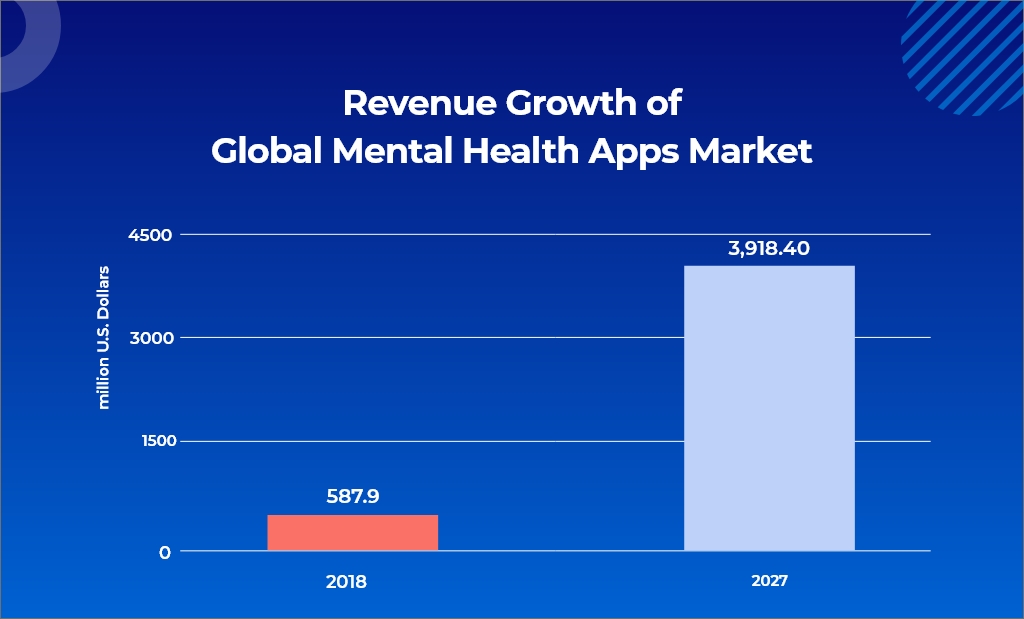
Behind developing any app, the main motive is always to make money from it. And, as per a research, the global mental health app market is expected to generate US$ 3,918.40 million by 2027 because of increasing levels of stress and anxiety among societies and lowering social interactions.
That means if you invest in developing a mood tracking app today – you will reap its benefits in terms of revenues in the coming years. This market is set to witness tremendous growth in the coming years which in turn will result in increased revenues of market players in the mental health app industry. So, if you want bigger returns, plan your investment in mood tracking app development today.
2. In the US, only 41% of the People who had a Mental Health Condition Received Professional Care
As per WHO, one out of every four people in the world battle with mental health issues, and 66% of those affected never get any type of help.
Why? Because mental health is still considered as a taboo in many countries and those suffering from mental issues feel hesitant while discussing it with anyone driving the growth of the market. The users can get better treatment.
For this reason, mental health apps are the best solutions that keep the privacy of users in mind while using the mental health applications as there wouldn’t be any revealing about it anywhere without the user’s consent.
3. While the World Is Stressing Out Solutions Are Available In North America Only
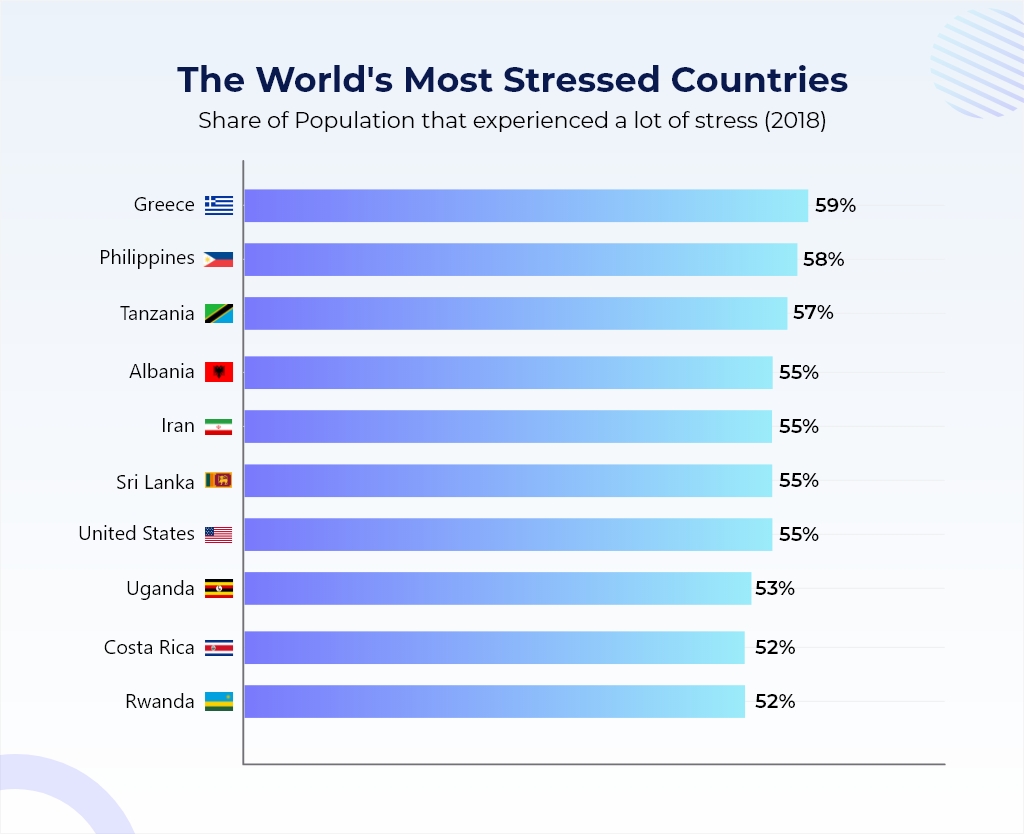
As per a survey by Statista, almost half of the population of all countries around the world is stressed out. However, mental health solutions are available for advanced economies only.
Presently, North America is the leading market for mindfulness apps. But, the worldwide burden of mental health is increasing day by day in many countries and the market of mental health solutions is almost empty over there.
So, if you are planning to launch a mood tracking app in such a country where there is still a lack of mental health solutions – you can easily take the first-mover advantage to win a hefty market share and make billions of dollars in revenues.
Now you must be having a clear picture of how big the mood tracking application market is and why it is a billion-dollar idea to invest in the same. But, on the other hand, it is also true that developing a solution to win any market is not as easy as a walk in the park – no matter what’s the competition and demand.
If you are planning to win a market, you must do deep research, make user personas, find out what your users need, and then address those in a precise manner. To do the same, you must know what types of mood tracking apps are already available in the market and what you will have to do to make yours stand out. So, let’s find it all.
3 Types of Mood Tracking Apps
Knowing all the good reasons, if you are excited about stepping into the mood tracking app market, you must know the competition first. In other words, be familiar with the industry trends, top players of the market, and their strategies before taking a decision related to building a mood tracker app.
Basically, Mood Tracking Apps are of the following three types:
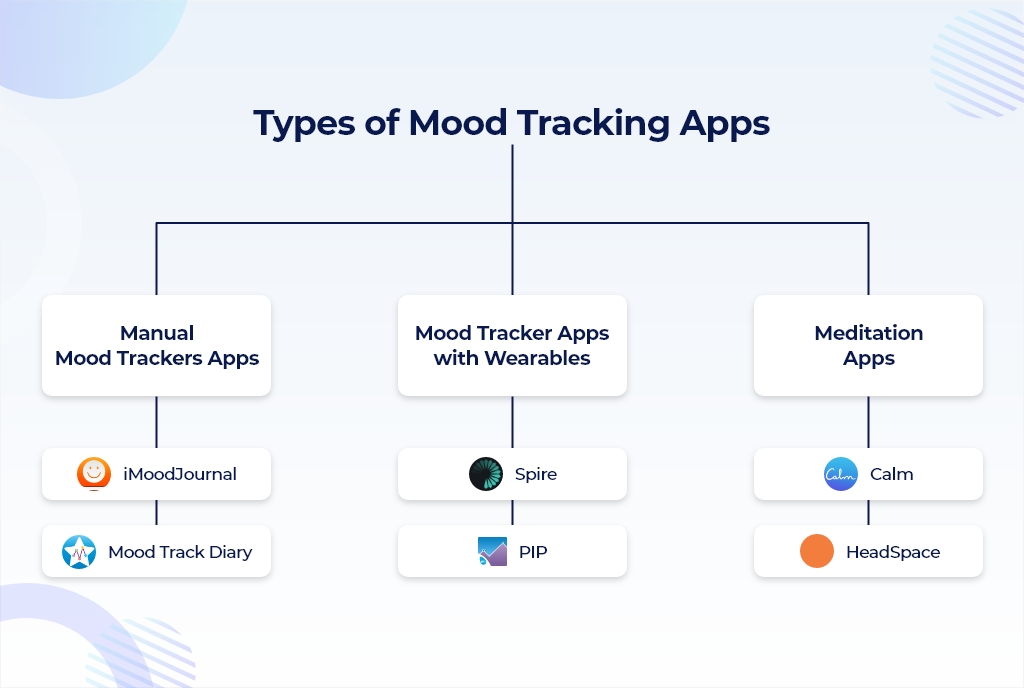
1. Manual Mood Tracker Apps
While using a manual mood tracking application, a user needs to put the entire information about how he is feeling manually into the app. These apps provide users a platform where they can set reminders for themselves, see the history of their mood changes in the form of graphs, and can improve their mood by doing various things like playing games, talking with friends, or simply listening to music.
2. Mood Tracker Apps with Wearables
This type of apps combine the functions of manual mood tracking apps with an automated collection of the required information. For example, these apps can use wearable devices to monitor physiological responses like blood pressure and breathing rate. Using this data, these apps create graphs that let users know what is going on inside the mind as well as the body.
3. Meditation Apps
The last type is mindfulness meditation apps. However, these apps do not help users in tracking mood but offer various ways to control it. By providing users with several guided meditations, these apps are doing wonders these days for improving the mood swings created by hustles of busy lives. Moreover, there are meditations for all occasions in such apps and users can choose the ones them depending on his/her current mood.
Now that we know all about the types of meditation apps – let’s see their examples and also find about the market leaders of this industry:
5 Market Players of the Mood Tracking App Industry
1. iMoodjournal
This is one of the best apps that fall into the category of manual mood tracking apps. It assists users in tracking their mood, energy, quality of sleep, stress, anxiety, and anything else that a user wants to document. The application helps users with pinpointing potential reasons for their mood swings and get invaluable insights about their mental state.
The easy to use interface of the app let users view their mood reports on a daily, weekly, or monthly basis. iMoodJournal also use hashtags using which a user can share his state of mind, feelings, and experiences. He can use these insights whenever required for analyzing the his thinking patterns in order to make necessary changes in his lifestyles.
2. MoodTrack Diary
This application is designed for users to let them keep track of their moods. It is designed to help people with feeling engaged with the ability to manage their moods by making informed decisions that impact how they are feeling.
It shows the user’s mood patterns on charts to find triggers that cause certain moods. The app also lets users interact with each other through social media so that they can give and receive feedback and help make life beautiful for each other. This application was made to be a useful expansion to people who are undergoing mental health treatment.
3. Daylio
Daylio is a well-known mood tracker application. It works as a mood monitor and lets users track their feelings without even typing a single word. Want to know how it functions? Daylio provides clients several videos that reflect various mindsets, and they simply need to pick the one that best explains their mood at that very moment.
The app comes handy for users who want to learn how to manage depression, stress, or anxiety. The application has a tool called “Statistics and Calendar” which lets users track their moods on a daily basis. The application also permits users to recognize emotions, patterns, behaviors, and they can also track their activities and include notes in the application if they think that it could be relevant.
4. Spire
This mood tracker application combines the functions of a manual mood tracker with the insights provided by a wearable device. Using its amazing functionality, it can monitor when people feel stressed, breathe heavily, or have increased heart rate. In such cases, it informs and insists the user to calm down and relax.
The app also notifies users if they need to get distract from anything that is causing mood swings and if they are not breathing properly. It tracks the user’s physical activities and lets them know if something is going wrong like if a user is sitting for too long. Along with these functions, the app also provides a number of meditation techniques for users to relax during the day.
5. Calm
The app Calm was named by Apple as 2017’s best iPhone App of the Year. Not just for Apple, among users as well, Calm is quickly becoming the most-loved meditation app available in the market.
It provides people experiencing depression and stress with guided meditations, breathing programs, sleep stories, and relaxing music. This application is truly universal; whether a user is new to meditation or a pro, he’ll find the perfect program for himself using the Calm app.
Now that you know all about the mood tracking app market, its major players and why you should develop a mood tracker app – let’s move ahead and find out what are the must-have features of a mood tracking app that you need to integrate into your own app to make it a success.

8 Must-Have Features of a Mood Tracking App
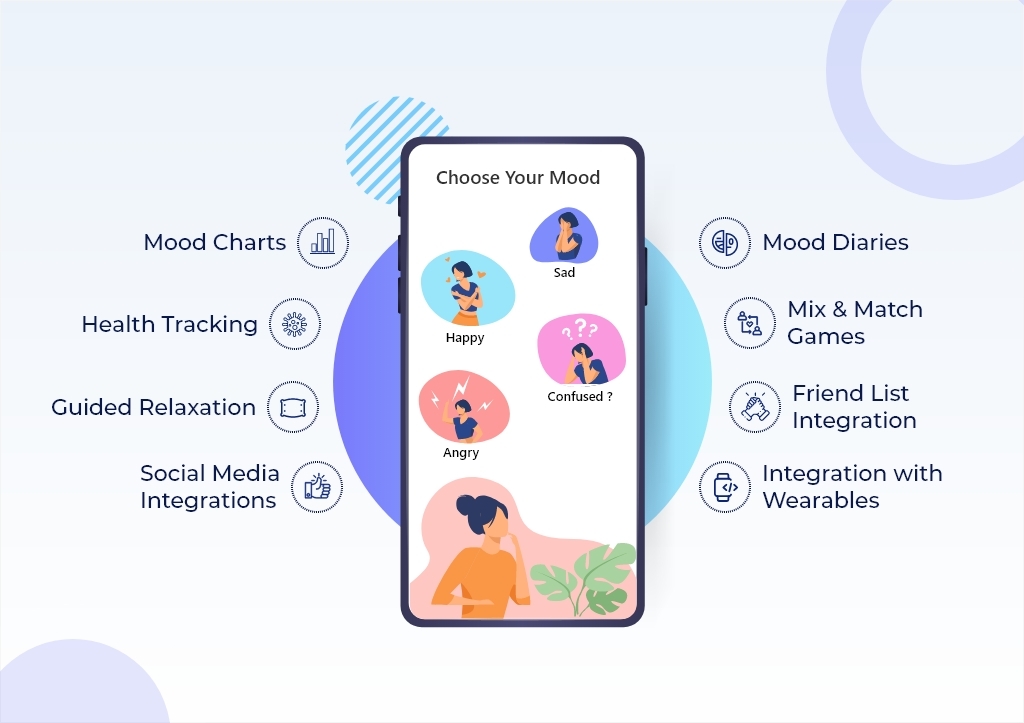
- Mood Diaries
If you are planning to develop a manual mood tracking app, this is a must-have feature. As clear from its name, the feature mood diaries let users feed information about how they are feeling during the day just in the same way we write our daily activities and achievements in our diary at the day’s end.
There are various applications that ask users various sets of questions which help them get a better understanding of their emotional state, how they fell into that state, and more.
- Health Tracking
This feature is a must-have if you are planning to build a mood tracking app that integrates with wearables. This feature lets users and doctors monitor health symptoms of the person using the app like heart rating, breath rate and get information about their progress in the field of depression, anxiety, stress, and other mental disorders.
- Mood Charts
It is a well-known fact that the human mind understands better using pictures or visual data. And that’s the reason why mood tracking apps should present outlines of a user’s feelings over time in the form of graphs and charts only.
Mood charts may vary in complexity from app to app but they all have the same function. They help users better understand the triggers, time, or places where their mood worsens. This way, users can get to know about things they shouldn’t do or places they should avoid visiting.
- Friend List Integration
If a user is stressed out or is having a bad day – then there is no doubt that he would like to talk to someone at that time. For this reason, your app must have a section of a friend list where a user can find people at times when he/she is feeling low. You should give users a chance to add friends from his/her contact list, social media, app community, or manually by adding a phone number or email id.
- Mix and Match Games
To make your app even better from others you can integrate games, audio lessons, activities, and tools for mood improvement in it. Integrating various games in your app can engage your users in the best possible way and can help relieve their stress, anger, and anxiety.
- Integration with Wearables
Without a doubt, your app should support integration with wearable devices in order to meet the modern needs of consumers. With it, a user can monitor his/her heartbeat, respiration rate, and several other things that will help him keep track of how his body performs when in stress or depression.
You can also provide your users with tools within the app that help them find how their thinking patterns cause stress and anxiety.
- Guided Relaxation
This feature will also provide value to your users by helping them relax when they are experiencing anxiety and stress. Expert guided meditation, personalized meditations lessons based on games, access to soothing music, and the ability to download meditation lessons for offline usage are some of the features that will help you make your app stand out.
- Social Media Integration
This feature of mood tracking apps let users easily share their data with specialists and others to make it feasible for the medical practitioners to collect and analyze their emotional state-of-mind in real-time to devise a better plan for fighting back the mental health issues.
So these are the features that are making users fall in love with mood tracking applications. If you are planning to invest in mood tracking app development and want a fair share of this market – here are a few tips and tricks by expert mood tracking app developers to win it.
6 Tips & Tricks to Make Your App Mood Tracking App StandOut
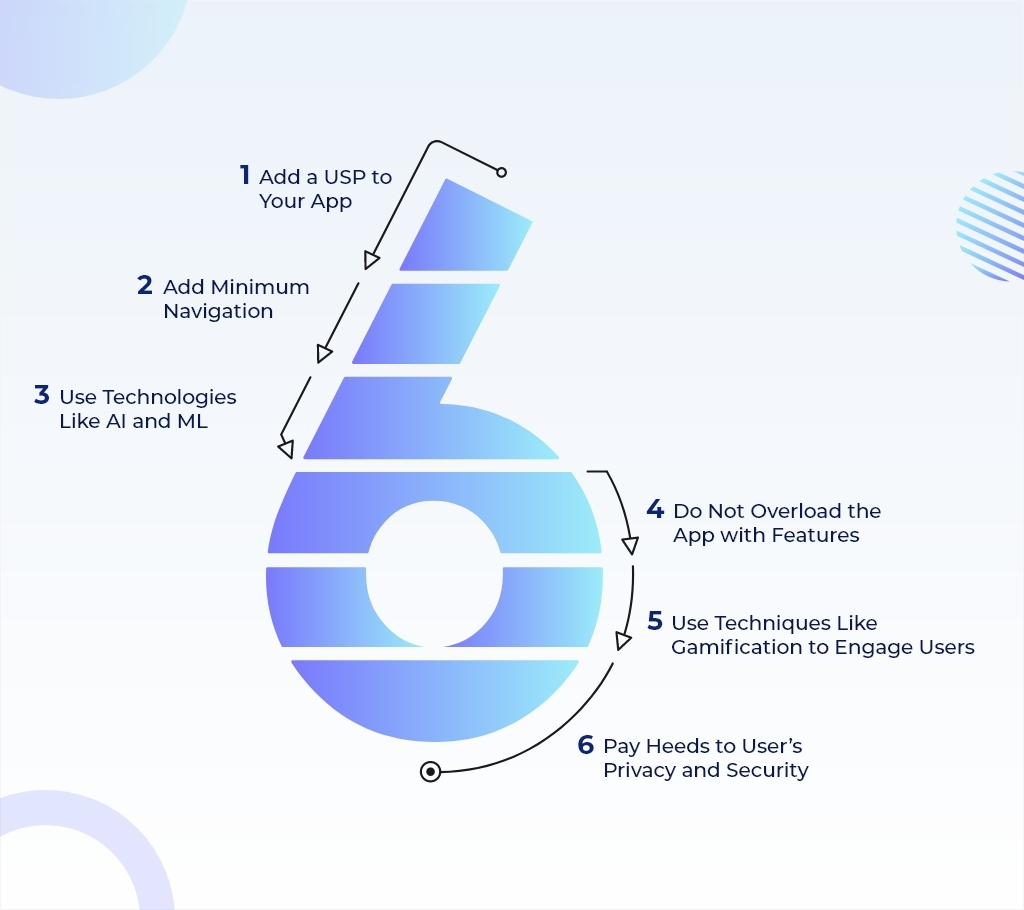
1. Add a USP to Your App
There is no doubt that presently there are a number of mood tracking apps available in the market. So, to make your app stand out you will have to add something unique into it. A win-win solution will be to add an emerging technology into your app to make it more engaging and helpful.
You can add a chatbot to your app or you can also consider adding IOT mood trackers in it. But, make sure you use these technologies carefully and not make your app bulky or irrelevant.
2. Add Minimum Navigation
The look and feel of a mood tracker app should be as pleasant and subtle as possible. Its users are going to be people who are already stressed out. So, it is your duty to make them feel comfortable while using your app and not lost. That’s why we recommend you use minimum navigation and as few design elements as possible.
3. Use Technologies Like AI and ML
When a user uses a mood tracking app – either he wants to relieve his stress or track what causes mood swings.
To help them do both these tasks, technologies like machine learning and artificial intelligence can be applied. Using this approach, users won’t just see the analytics but will also understand the effect of various factors on their moods. Alongside that, the feature will find and recommend the best practices to lift the mood or cheer up a user based on personalized suggestions and preferences. And, on the other hand, your app will get the success you always desired.
4. Do Not Overload the App with Features
But, adding these technologies doesn’t mean that you should load your app with features. Make sure to not confuse your already confused and stressed users by adding waste of time features into your app. Rather try to keep it as subtle and simple as possible.
5. Use Techniques Like Gamification to Engage Users
Gamification is an amazing way to engage users and make them regular customers of your application. There are numerous ways using which you can engage your users with your app, for example, by rewarding them with points when they don’t feel stressed or by providing them with access to a premium account for free.
6. Pay Heeds to User’s Privacy and Security
While developing a mood tracking app, you will have to make sure that it doesn’t compromise with your user’s security and privacy to maintain a strategic difference from data breaches and scams. Remember, data security is of utmost importance for every user and it should be for you as well.
But, How Much Does it Cost to Build a Mood Tracking App?
Now that you know all about mood tracking apps – it must be clear to you that no such app is having similar features or business models. Each app is different and unique on its own and thus one size doesn’t fit all.
The cost to develop a mood tracking application relies on various factors. This includes the type of features you want to add in your app, the tech stack you chose to build it, and platforms you want to target. So, it is a bit difficult to say that it will cost you exactly XXX dollars.
Therefore, it is advisable not to look for cost without knowing your exact requirements. Rather, look forward to knowing the cost-affecting factors and get an estimate by talking to one of our expert mood tracking app developers. However, if you wish to know a ballpark figure of how much it will cost you to develop a mood tracking app, then we would say that it will cost you something in between $30k – $40k.

Rate this article!
Join 60,000+ Subscribers
Get the weekly updates on the newest brand stories, business models and technology right in your inbox.

Humane yet subtle, Naiya is a girl full of ideas about almost everything. After earning a bachelor’s degree in computer science and engineering, she decided to merge her technical knowledge with her passion for writing – to accomplish something interesting with the fusion. Her write-ups are usually based on technology, mobile apps, and mobile development platforms to help people utilize the mobile world in an efficient way. Besides writing, you can find her making dance videos on Bollywood songs in a corner.

Telemedicine 2.0 - A Comprehensive Guide On What Healthcare Providers Need To Know?
Discover how the latest advancements like Artificial Intelligence in telemedicine are reshaping patient care. This comprehensive resource offers insights into the key trends and innovations driving this shift, providing valuable knowledge for healthcare professionals looking to stay ahead.
Download Now!Worried about
development cost?
Pay in EASY and FLEXIBLE INSTALLMENTS.


















